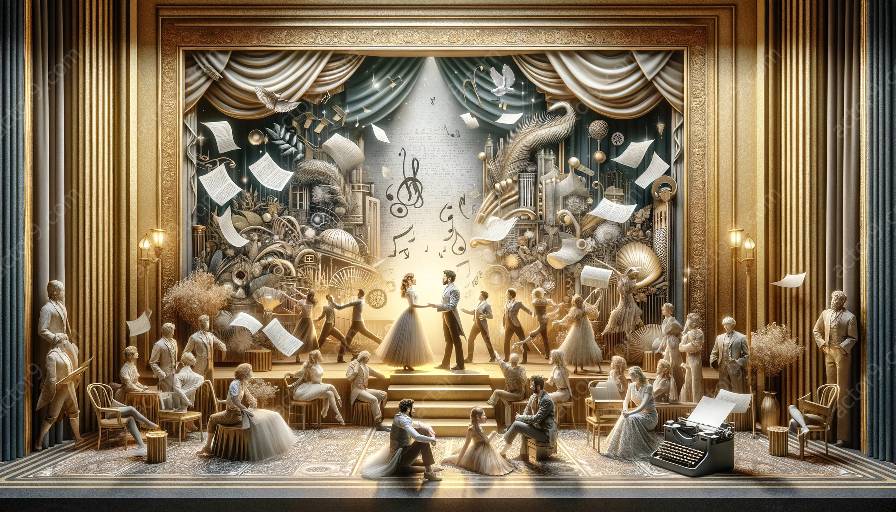Character development and portrayal are crucial elements that bring musical theatre scripts to life, shaping the narratives and engaging audiences in captivating storytelling. In musical theatre scriptwriting, the creation and depiction of characters play a central role in delivering powerful performances and resonating storytelling. Understanding the nuances of portraying characters in musical theatre scripts is essential for scriptwriters, directors, and performers to craft authentic and relatable narratives that leave a lasting impact.
The Importance of Character Development in Musical Theatre
Character development in musical theatre scripts is the process of creating and evolving characters throughout the narrative to make them multi-dimensional, complex, and compelling. Characters serve as the heart and soul of musical theatre productions, driving the plot forward and connecting with audiences on an emotional level. By delving into the depths of a character’s motivations, flaws, and aspirations, scriptwriters can infuse authenticity and depth into the storytelling, fostering empathy and resonance among the audience.
Character development goes beyond merely outlining the traits and backgrounds of characters. It involves crafting their emotional journeys, personal growth, and transformative arcs that resonate with universal themes and human experiences. Each character’s development in a musical theatre script contributes to the overarching narrative, creating an intricate web of relationships, conflicts, and resolutions that captivate and inspire audiences.
Techniques for Effective Character Development
Exploring Backstories: Delve into the characters’ past experiences, relationships, and significant events that have shaped their identities and perspectives. Understanding their backstories helps shape their present actions and decisions in the musical.
Complex Motivations: Characters should have nuanced and layered motivations that drive their behavior, decisions, and interactions with other characters. These motivations should be rooted in authentic emotions and desires, adding depth to their portrayal on stage.
Emotional Vulnerability: Characters need to exhibit vulnerability and emotional depth to resonate with audiences. Their struggles, conflicts, and moments of vulnerability create empathy and connection with the audience, making their journeys relatable and impactful.
The Art of Portrayal in Musical Theatre Scripts
Portraying characters in musical theatre scripts involves bringing the written words to life on stage through compelling performances and authentic portrayals. It requires collaboration between scriptwriters, directors, and performers to convey the essence of characters with depth, empathy, and authenticity, enriching the overall storytelling experience.
Effective portrayal of characters hinges on the seamless integration of scriptwriting, directing, and acting, aligning the creative vision to bring out the nuances and complexities of each character. It involves understanding the subtleties of character traits, body language, vocal inflections, and emotional expressions to breathe life into the characters and engage the audience’s imagination.
Character Portrayal Techniques
Physicality and Vocal Expression: Characters’ physical movements and vocal intonations should reflect their personalities, emotions, and inner conflicts. Paying attention to physicality and vocal expression enhances the authenticity of character portrayals, making them resonate with the audience.
Emotional Truthfulness: Authentic portrayals stem from genuine emotions and truthful performances. Characters should convey a range of emotions with honesty and vulnerability, eliciting empathy and connection from the audience.
Character Dynamics: Understanding the dynamics between characters and their relationships is essential in portraying authentic interactions and conflicts. Capturing the nuances of character dynamics adds depth and richness to the storytelling, fostering compelling performances.
Impact of Character Development and Portrayal on Musical Theatre
Character development and portrayal significantly influence the overall impact and success of a musical theatre production. Well-crafted characters with compelling development and authentic portrayal deepen the audience’s immersion in the narrative, creating memorable experiences and emotional resonance that lingers long after the curtain falls.
By investing in character development and portrayal, musical theatre scripts elevate the storytelling to new heights, resonating with diverse audiences by offering relatable, empathetic, and thought-provoking narratives. Characters that undergo meaningful development and are authentically portrayed become the focal points of emotional engagement, driving the success and enduring legacy of musical theatre productions.
Conclusion
In essence, character development and portrayal form the bedrock of captivating storytelling in musical theatre scripts. By imbuing characters with depth, authenticity, and emotional resonance, scriptwriters and creatives can shape narratives that leave an indelible impact on audiences. Understanding the intricacies of character development and portrayal equips musical theatre practitioners with the tools to craft compelling, relatable, and unforgettable characters that breathe life into the enchanting world of musical theatre.




































